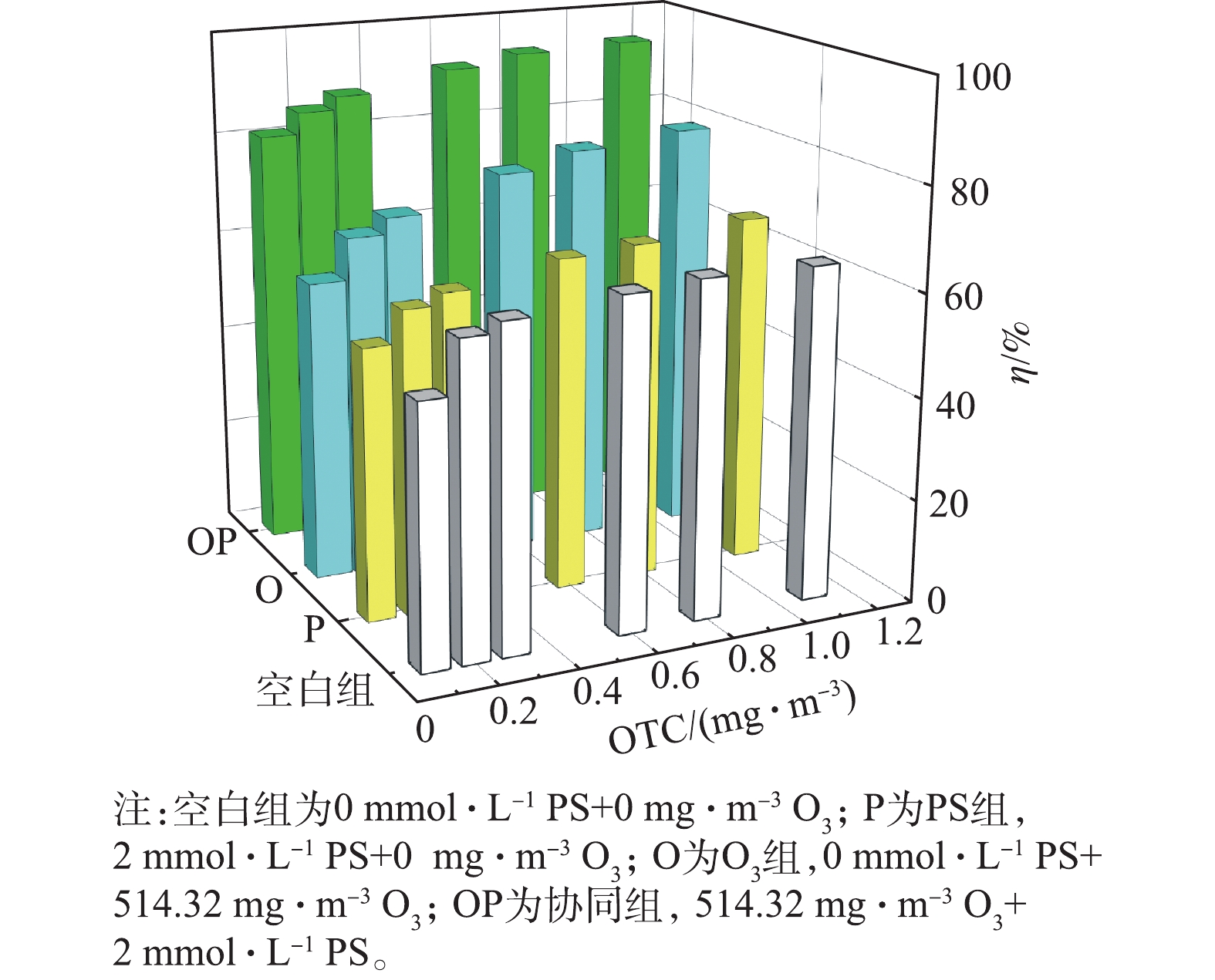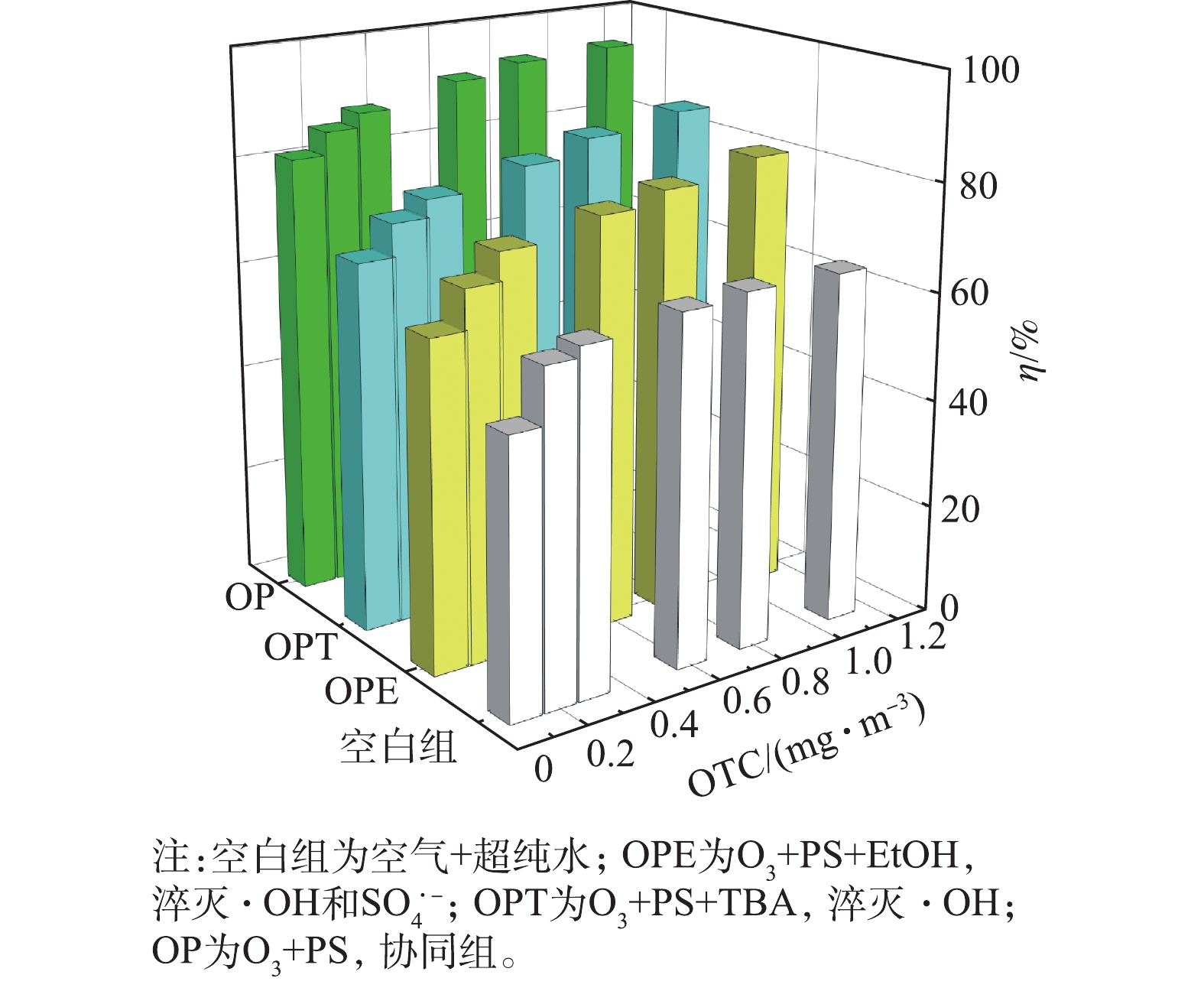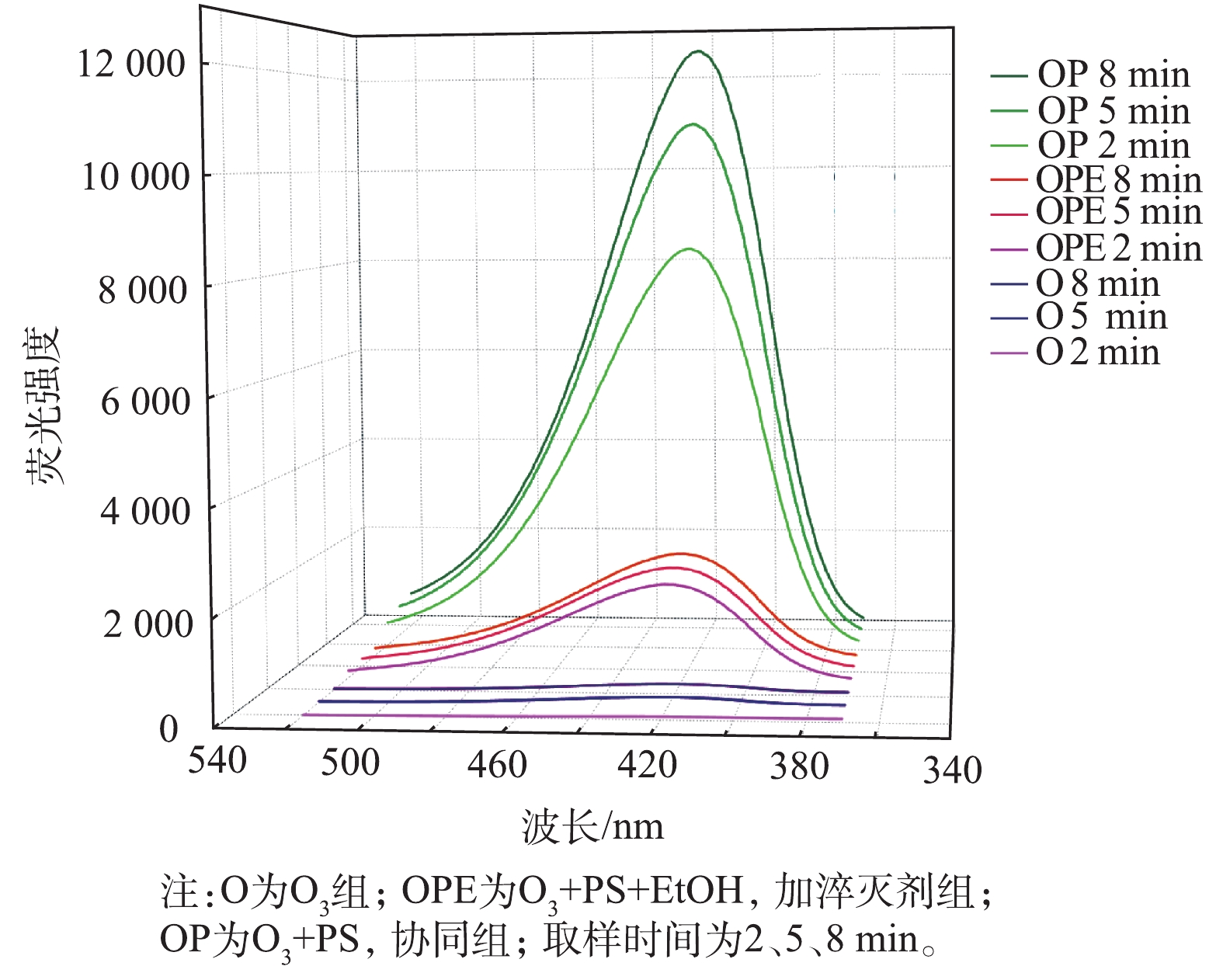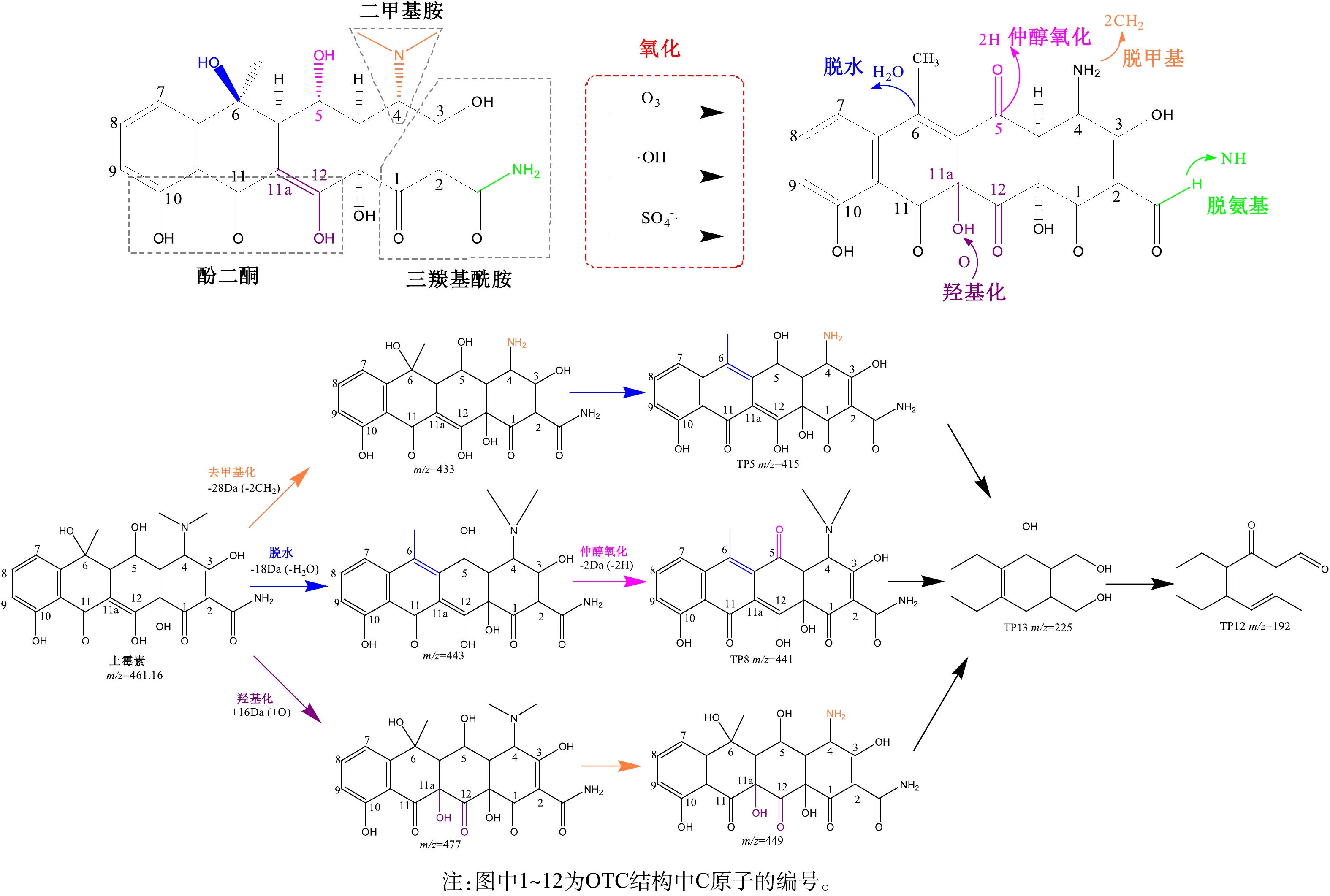-
作为新兴药类污染物的抗生素,被大量用作兽药投加到禽畜养殖中,这些抗生素在动物肠道中无法被完全吸收,多达30%~90%的母体化合物会通过粪便或尿液排出[1]。四环素类抗生素的广泛使用使得动物粪便中残留大量的四环素[2]。动物粪便中的抗生素可利用高温堆肥处理技术来降解,堆肥温度可达70 ℃[3],甚至90 ℃[4]。土霉素(OTC)经过堆肥后的降解产物仍是大分子物质EOTC (m/z=461)、α-apo-OTC (m/z=443)和β-apo-OTC (m/z=443)[5]。堆肥中混合的抗生素、ARGs及菌体可被释放到大气环境中,人体长期暴露在这种环境中会导致传染病、毒性影响、过敏和癌症等风险[6],并且ARGs会降低抗生素治疗的功效[4]。
近年来,处理OTC的方法多种多样,包括高级氧化、吸收法、化学氧化、电化学和生物法等[7]。KARPOV等[8]用Fe(Ⅲ)和Mn(Ⅳ)来降解OTC;ÇELIK等[9]在膜生物反应器中用硝化菌降解OTC;HARRABI等[10]用河口沉积物中原生的细菌来降解OTC;LI等[11]和USLU等[12]用臭氧氧化来降解OTC。臭氧能快速与有害有机物反应并将其分解,将有机物降解成更简单的产物[11, 13]。为提高O3对有机污染物的降解效率,常将O3氧化与其他氧化过程结合起来,如UV/O3预处理PAHs、VOCs、CPs、APs和DBPs[14-15],O3/微波降解活性污泥[16],臭氧-过硫酸钠(O3/PS)降解布洛芬[17]、硝基苯[18]、渗滤液[19]和氯苯甲酸[20]。在这些与臭氧结合的方法中,PS具有强氧化性、宽的酸碱度范围、高溶解性[21],且PS产生的
SO⋅−4 自由基会选择性地与土霉素的富含电子的芳香族或共轭双键部分反应[22]。因此,以O3/PS技术降解OTC具有较好的适用性。目前,关于OTC的研究主要集中在水体和土壤,含OTC的废气处理在国内外却鲜见报道。本研究采用O3/PS协同降解废气中的OTC,在雾化喷淋装置中探究O3及PS对废气中OTC的去除率,并解析各去除作用的贡献率,通过LC-TOF-MS/MS对OTC的降解产物进行分析鉴定,推测降解机理与途径,以期为含OTC废气处理产业化应用提供参考。
全文HTML
-
O3/PS协同降解OTC废气的实验装置如图1所示。喷淋塔由D×H=3 cm×50 cm的透明玻璃柱构成,玻璃柱外包覆锡纸避光。喷淋液由雾化喷嘴(孔径0.8 mm)形成喷雾后,均匀喷入。模拟OTC废气采用动态法配制,通过加热和鼓吹OTC浓溶液制得,将装有100 mg·L−1 OTC溶液的孟氏洗瓶(500 mL)放入恒温水浴锅(BHS-2)中加热(100 ℃),同时用空气压缩机泵入空气,鼓泡吹出含OTC的混合气体。由台式臭氧发生器(CH-ZTW6G)产生的臭氧和OTC废气混合后,一起从底部进入喷淋塔,混合气在上升过程中与喷淋液接触、反应,经过O3/PS降解后的废气从喷淋塔顶部排出;反应后的喷淋液流入循环槽中,在潜水泵的作用下重新进入喷淋塔,每运行0.5 h,更换新鲜喷淋液。实验所涉及的溶液均由超纯水配制。
O3/PS喷淋塔对OTC的去除性能实验在OTC进气流量为2.4 L·min−1,O3进气流量为0.9 L·min−1,雾状喷淋液流速为30 mL·min−1的条件下进行。实验包括4个步骤。
1)控制进气OTC浓度为(0.7±0.1) mg·m−3,通过改变进气中O3的浓度和喷淋液中PS的浓度,研究O3和PS剂量对OTC去除率的影响。喷淋液中PS的投加量分别为0、0.5、1、2 mmol·L−1,以超纯水作为空白组(投加量为0)。O3浓度梯度设为0、128.58、385.74、514.32、771.48 mg·m−3,以空气作为空白组(浓度为0)。
2)通过控制O3和PS来探究O3和PS对OTC的去除作用及贡献率。实验分为4组:空白组(超纯水和空气)、单独O3、单独PS和O3/PS协同,其中PS的浓度均为2 mmol·L−1,O3的浓度均为514.32 mg·m−3。
3)通过控制
SO⋅−4 和·OH来区分2种自由基分别对OTC的去除作用及贡献率。实验分为4组:无自由基、SO⋅−4 和·OH、淬灭SO⋅−4 和·OH、淬灭·OH。空气和超纯水作为运行条件时无自由基产生,2 mmol·L−1 PS和514.32 mg·m−3 O3结合时能同时产生SO⋅−4 和·OH,加入乙醇(EtOH)可以同时淬灭SO⋅−4 和·OH,加入叔丁醇(TBA)就只淬灭·OH。2种淬灭剂以0.5 mol·L−1的剂量加投到2 L的PS喷淋液中。4)验证自由基的存在,并定量观察自由基的产生量。OTC废气发生装置中的OTC溶液换成超纯水,在PS喷淋液中加50 mL对苯二甲酸(0.5 mmol·L−1)。实验分为3组:514.32 mg·m−3 O3,514.32 mg·m−3 O3+2 mmol·L−1 PS,514.32 mg·m−3 O3+2 mmol·L−1 PS+EtOH。在装置运行2、5、8 min后,取反应后的喷淋液2 mL,再用超纯水稀释4倍后,检测对苯二甲酸被·OH氧化后的荧光产物强度。
-
臭氧浓度用臭氧检测仪(ZCP-O3)检测,测量范围为0~2 143 mg·m−3。羟基自由基(·OH)强度用荧光分光光度计(SHIMADZU RF-6000)间接检测,激发光波长为315 nm,发射波长为370~520 nm。气体和液体流量采用玻璃转子流量计(LZB-3)控制,量程分别为0~1.5 L·min−1和0~100 mL·min−1。
OTC进出气浓度检测方法:用1 mL甲醇在采样点吸收含OTC的混合气5 min后,再用紫外可见分光光度计在354 nm波长处测量吸收液的吸光度,根据标准曲线换算出吸收液中OTC浓度,再以式(1)换算出OTC在进气和出气中的浓度。
式中:Cg为空气中OTC的浓度,mg·m−3;Cl为吸收液中OTC的浓度,mg·L−1;Vl为吸收液体积,mL;t为吸收时间,min;Qg为取样口的气体流量,mL·min−1(进气口为OTC进气流量,出气口为进气OTC流量和O3进气流量之和)。由于气体发生温度为100 ℃,高温OTC废气携带了水蒸气,1 mL的甲醇吸收液同时起到冷凝和吸收的作用,因此,吸收后的溶液为甲醇、水和OTC的混合液,即Vl为混合液的总体积。
OTC中间产物的鉴定采用高分辨液质联用仪(Ultimate3000-timsTOF)和Hypersil GOLD C18柱(1.9 μm,2.1 mm×100 mm),样品注射体积为3 μL,柱温为40 ℃,流速为0.3 mL·min−1。流动相为0.1%甲酸(A)和乙腈(B),洗脱过程为梯度洗脱:0~2 min,5%~60% B;2~8 min,60%~100% B;8~10 min,100% B;10~12 min,5% B。
1.1. 实验装置与步骤
1.2. 分析与计算方法
-
臭氧-过硫酸钠喷淋协同降解OTC的去除性能如图2所示。空气和超纯水代替O3和PS的空白组(0 mg·m−3 O3+0 mmol·L−1 PS)对OTC的去除率为64.5%。当空气(0 mg·m−3 O3)和2 mmol·L−1 PS喷淋液协同作用时,喷淋塔对OTC的去除率为65.5%,说明单独的PS达到的去除率和空白组相差甚微。当514.32 mg·m−3 O3和超纯水(0 mmol·L−1 PS)协同作用时,喷淋塔对OTC的去除率为79.9%,比空白组高了15.4%,说明单独的O3可以去除部分OTC。当514.32 mg·m−3 O3和2 mmol·L−1 PS喷淋液协同作用时,OTC去除率为94.7%,较单独的PS对OTC的去除率增加了29.1%,较单独的O3对OTC的去除率增加了14.9%。因此,在相同OTC进气浓度下,O3和PS协同降解OTC的去除率比单独的O3或单独的PS高。此外,OTC的去除率与O3和PS的剂量呈正相关。以2 mmol·L−1 PS作为喷淋液,通入的O3浓度从514.32 mg·m−3降到128.58 mg·m−3时,OTC去除率由94.7%降至89.1%;通入514.32 mg·m−3 O3时,在PS浓度由2 mmol·L−1降至0.5 mmol·L−1的过程中,OTC去除率由94.7%降至85.5%。
-
如图3所示,根据4种条件下OTC的去除率的差异,探究了PS和O3对OTC去除作用的贡献率。当OTC进气浓度为0~1.2 mg·m−3时,单独PS喷淋所达到的去除率和空白组相差无几,为50%~65%;单独O3作用时,OTC去除率为58%~80%,较空白组高6.2%~15.9%;同时存在O3和PS时,OTC去除率为81%~95%,较空白组高25.6%~31.5%,较单独O3时高13.9%~23.2%。PS需要O3、催化剂等活化剂活化后才能产生
SO⋅−4 自由基,因此,单独的PS缺乏激活因子,无SO⋅−4 氧化剂的产生,OTC的去除率很难得到提升[18, 23]。由于O3对有机物有氧化作用,能降解土霉素[18],故单独臭氧时,OTC的去除率较空白组高。当O3和PS协同时,O3活化产生的SO⋅−4 对含不饱和键和芳香环的污染物有较高的去除率,可选择性地高效去除具有不饱和键和芳香环等结构的OTC;同时SO⋅−4 也会促进臭氧分解产生·OH[18],两者的链式反应加快了OTC的降解。在没有氧化剂的条件下,抗生素在水溶液中的降解方式为光解和水解[24]。本实验中喷淋塔外包覆了锡纸避光,避免了光解对OTC去除的影响。实验条件下(25 ℃,pH=7,避光),土霉素在纯水中水解速率为(0.101±0.002) d−1[25]。因此,空白组对OTC的去除主要是超纯水的吸收作用,土霉素仍以母体形式转移到了水相中,装置运行20 min,循环液中吸收的OTC浓度为0.487 mg·L−1。而O3/PS的加入带来了臭氧及自由基的氧化作用,氧化作用使土霉素降解为较小分子质量的产物,也降低了吸收在循环液中的土霉素的浓度。装置运行20 min后,循环液中吸收的OTC浓度为0.039 mg·L−1。因此,在O3/PS协同降解OTC废气的体系中,雾化喷淋液吸收了50.0%~65.1%的OTC,O3的氧化作用增加了6.2%~15.9%的去除率,加入PS后,因为生成了·OH和SO⋅−4 ,加速了OTC的氧化,去除率提高了13.9%~23.2%。随着进气OTC浓度的增大,OTC的去除率随之升高。在O3和自由基氧化降解OTC的过程中,发生电子转移,产生以C为中心的自由基中间体。OTC在·OH自由基的攻击下,电子转移到—N(CH3)2的N原子上,产生胺基阳离子。α-C进一步去质子化,产生了以C为中心的自由基。另外,在OTC的仲醇氧化过程中,·OH自由基攻击OTC的C5后,转化为以碳为中心的碳自由基,反应中产生的有机物自由基可以继续参与·OH自由基生成的链式反应[26],增加了体系中·OH的量,并且这些有机物自由基也可能会对OTC有直接降解作用。随着进气OTC的增加,喷淋塔中的中间产物自由基也在增加,加速了OTC的降解进程。
-
O3/PS较单独O3有更高效降解率的原因是,
SO⋅−4 和·OH 2种自由基促进了有机物的氧化进程[18]。因此,须加入自由基淬灭剂到喷淋液中,以探究喷淋塔中SO⋅−4 和·OH 2种自由基对OTC去除的贡献率。乙醇(EtOH)能够高效淬灭SO⋅−4 和·OH,叔丁醇(TBA)能高效淬灭·OH,对SO⋅−4 的淬灭效率较差[27]。为了排除淬灭剂对OTC去除的干扰作用,在空白组(空气+超纯水)中,分别加入EtOH和TBA 2种淬灭剂,对比淬灭剂加入后装置对OTC去除率的变化。结果表明,进气OTC浓度控制为(0.67±0.03) mg·m−3时,3种条件下装置对OTC的去除率均在(65.6±1.0)%,表明淬灭剂的加入对OTC的去除无影响。SO⋅−4 和·OH 2种自由基对OTC去除作用的贡献率如图4所示。比较OPE、OPT、OP 3组数据,加入EtOH淬灭·OH和SO⋅−4 2种自由基后,OTC的去除率降低了13.1%~21.2%;加入TBA淬灭·OH后,喷淋塔对OTC废气的去除率降低了8.6%~13.7%。这表明体系中·OH和SO⋅−4 同时存在并且都对OTC的去除起作用。·OH和SO⋅−4 对OTC的去除率分别占8.6%~13.7%和4.5%~7.5%,·OH氧化占有更高的贡献率。对比OPE和空白组的数据,加入EtOH淬灭·OH和SO⋅−4 后,OTC的去除率仍比空白组高10%~16%,说明仍有能降解OTC的氧化作用存在。CHEN等[28]用乙醇和XIE等[29]用甲醇作为自由基淬灭剂时也出现与本实验相一致的结果。臭氧除了具有·OH间接氧化作用外还有直接氧化作用[18],因此,加入EtOH淬灭·OH后,仍有臭氧的直接氧化作用在降解OTC废气,还可能存在未被淬灭的残余自由基在氧化降解OTC废气。为了说明单独的O3是否存在间接氧化作用以及被EtOH淬灭后是否存在残余自由基,对·OH产量进行了测定实验。·OH会被对苯二甲酸捕获并生成强荧光物质2-羟基对苯二甲酸,产物的荧光强度和·OH浓度成正比[30]。由图5可知,2-羟基对苯二甲酸的荧光峰值出现在425 nm处,因此,本实验以425 nm处的荧光强度来表征·OH的最大生成量。荧光强度随时间的延长而增强,说明在反应器内·OH一直在生成,荧光产物得以累积。喷淋塔在只有O3的条件下,运行5 min后,喷淋液中2-羟基对苯二甲酸的荧光强度为173.3。这说明在O3单独存在时,2-羟基对苯二甲酸的荧光强度相对微弱,即·OH的产生量相对稀少。因此,O3对OTC废气6.2%~15.9%的去除率主要是由臭氧直接氧化产生的,靠臭氧产生·OH的间接氧化作用可以忽略。喷淋塔在O3和PS同时存在的条件下,运行5 min后,喷淋液中2-羟基对苯二甲酸的荧光强度为10 899。这说明有PS协同作用时,激发的
SO⋅−4 会促进O3分解并产生大量的·OH,亦验证了O3/PS协同降解OTC废气时效率最高。加入淬灭剂EtOH后,荧光强度明显下降,但仍然还有2 055.9的荧光强度,说明EtOH的加入并没有完全淬灭自由基,还有残留的自由基在氧化降解OTC。因此,加入EtOH淬灭剂后,OTC仍有较高去除率的原因在于O3的直接氧化作用和残余自由基的共同氧化作用。综上所述:OTC总去除率为81.5%~94.7%,喷淋液吸收的OTC占50.0%~65.1%,O3直接氧化作用占6.2%~15.9%;加入PS后,OTC的去除率增加了13.9%~23.2%,增加的这部分由8.6%~13.7%的·OH氧化作用和4.5%~7.5%的
SO⋅−4 氧化作用组成,此外,还有0~3.4%未被检测到的残余自由基。 -
OTC经过O3/PS的氧化作用,主要生成了TP5C20H18N2O8(m/z=415.15)、TP8C22H20N2O8(m/z=441.13)、TP12C12H16O2(m/z=192.13)、TP13C13H21O3(m/z=225.19) 4种中间产物,结合OTC中间产物的分子离子和二级碎片的质谱信息,可推测出这4种主要中间产物的降解路径。
O3/PS协同降解OTC的机理及途径如图6所示。
SO⋅−4 选择性地与富含电子的芳香族或共轭双键部分反应[22],同时O3作为亲电试剂,也容易攻击分子结构中的富电子区域[31]。OTC的氧化还原反应容易在二甲基胺、三羰基酰胺及苯酚二酮基团这几个易电离的部位发生[8, 32]。OTC主要经过3种路径降解。第1种途径是OTC C4所连接的二甲基胺[—NCH3)2]在·OH自由基的攻击下,电子转移到—N(CH3)2的N原子上,产生胺基阳离子。α-C进一步去质子化,产生了以C为中心的自由基,该自由基随后可以与氧化剂快速反应,然后生成亚胺。亚胺不稳定,快速水解生成m/z=433的中间产物[33]。在此基础上,C6所连羟基脱水得到TP5(m/z=415),再降解为TP13(m/z=225)和TP12(m/z=192)。
第2种路径是OTC的C6先脱水生成m/z=443的中间产物,·OH自由基攻击C5后转化为以碳为中心的碳自由基[26],随后加入氧生成过氧化物基团,氢过氧基团被消除后,再产生产物TP8(m/z=441)[32],再进一步降解为TP13(m/z=225)和TP12(m/z=192)。
第3种路径是O3攻击OTC的C11a和C12之间的双键,发生1, 3-偶极环加成反应[34],加入氧原子,生成m/z=477的产物,通过去甲基作用得到m/z=449的中间产物,再进一步降解为TP13(m/z=225)和TP12(m/z=192)。
2.1. O3/PS喷淋塔对OTC的去除性能
2.2. O3和PS对OTC去除率的贡献
2.3.
SO⋅−4![]()
![]()
和·OH 对OTC的去除作用
2.4. 中间产物与反应过程机理探讨
-
1)采用臭氧-过硫酸钠(O3/PS)协同降解OTC废气,OTC去除率可达94.7%。
2) O3/PS协同降解OTC废气的机制为:O3和PS协同产生·OH和
SO⋅−4 ,在O3直接氧化的基础上,进一步提高了OTC废气的氧化效率。O3和PS协同氧化作用主要包括6.2%~15.9%的O3直接氧化,8.7%~11.9%的·OH氧化和4.3%~7.5%的SO⋅−4 氧化。3) LC-TOF-MS/MS分析结果表明,C20H18N2O8、C22H20N2O8、C12H16O2、C13H21O3为OTC降解的主要中间产物。









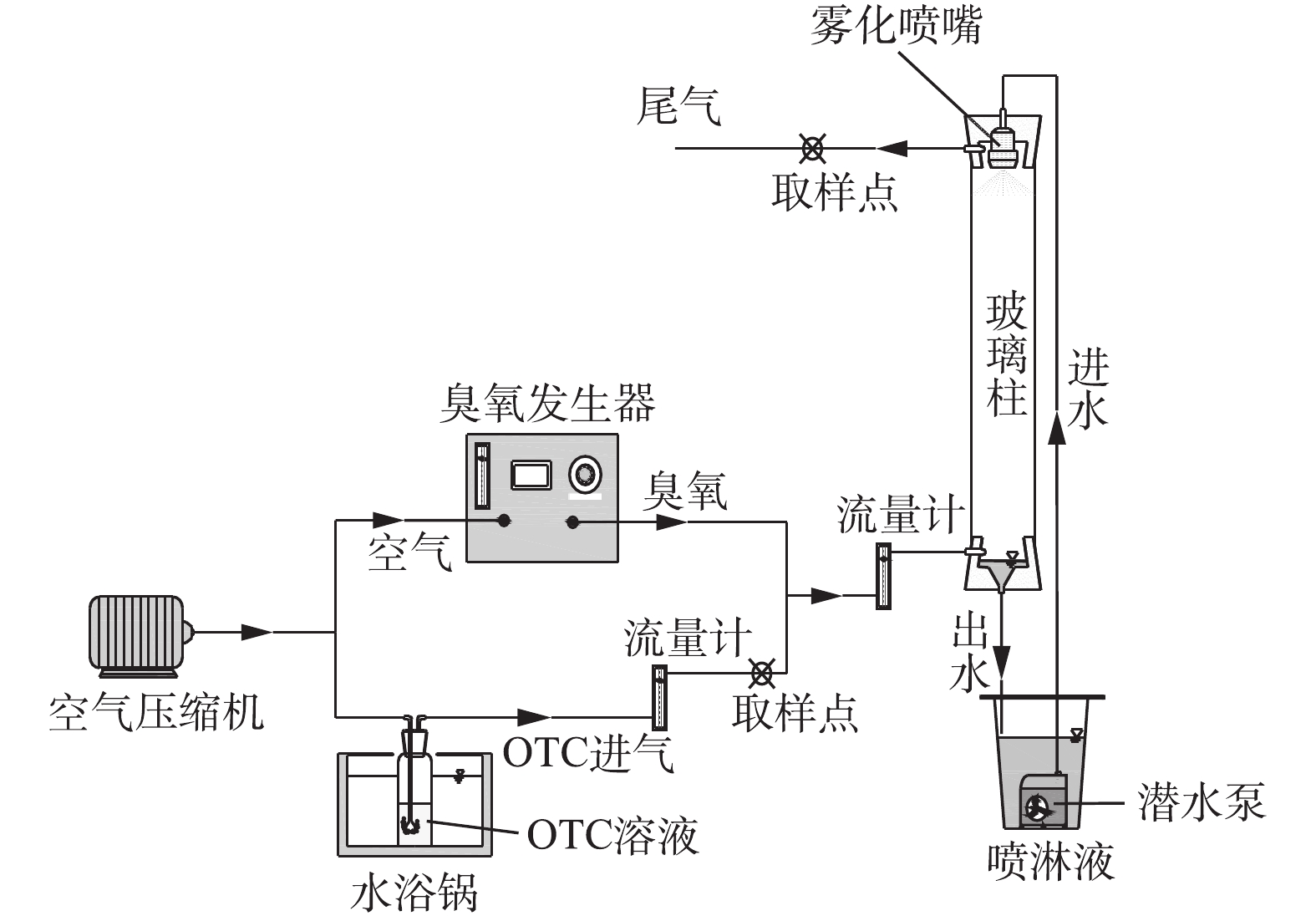
 下载:
下载:

